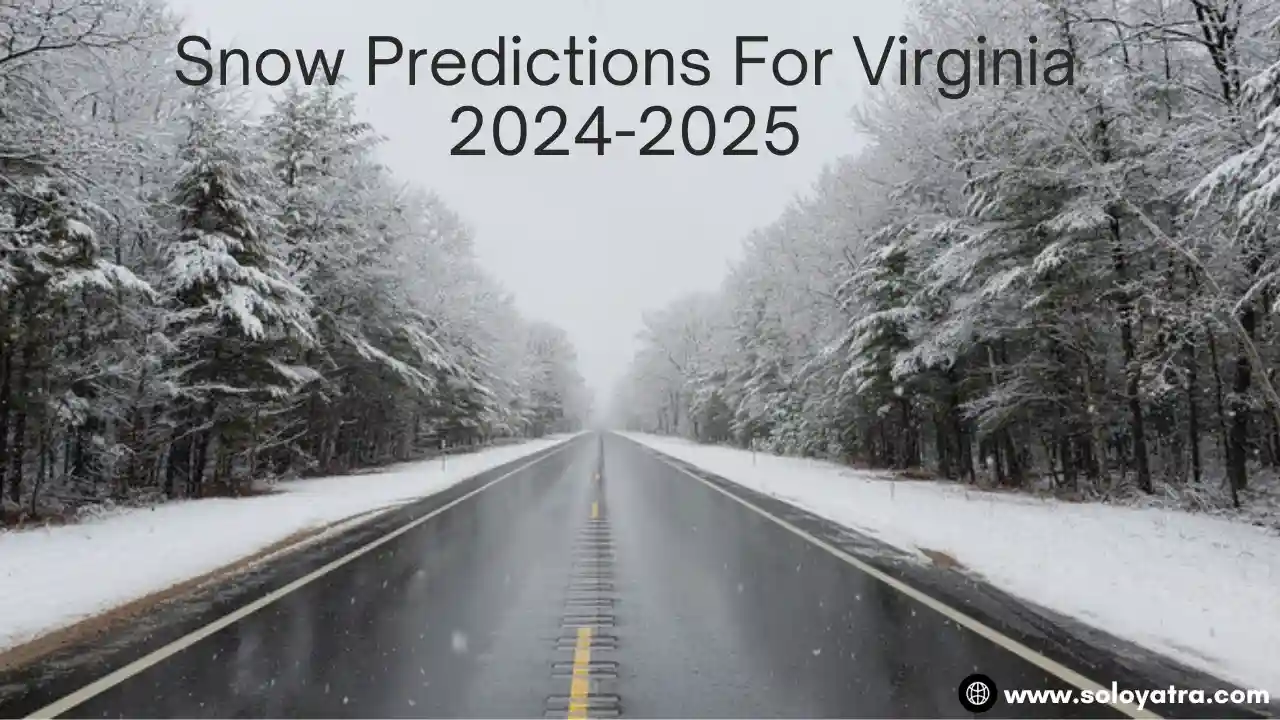What to Expect: Snow Predictions For Virginia 2024-2025
For many Virginians, winter brings questions about how much snow will fall and how it may impact daily life. This article provides the latest insights on snow predictions for Virginia 2024-2025 winter season, with a focus on delivering the information readers need most.
Whether you love sledding and snowmen or dread icy commutes, understanding what to expect this winter can help you plan ahead. We’ll explore the forecasted snow totals from expert sources, compare them to past Virginia winters, highlight local impacts, provide preparation tips, and offer unique insights from weather specialists.
Let’s dive into the snow predictions and winter outlook for the season ahead in Virginia.
Snow Predictions For Virginia 2024-2025
To directly answer readers’ key questions, here are the highlights of what expert forecasters are predicting for Virginia snow this winter:
- The 2024 Old Farmer’s Almanac predicts above-normal winter precipitation for most of Virginia, with the potential for heavy snow events [1].
- The Farmers’ Almanac 2024-2025 winter outlook calls for an active storm track affecting the Southeast and Mid-Atlantic regions, likely bringing above-average snowfall to Virginia [2].
- NBC4’s Storm Team4 expects 30-40 inches of snow for the immediate D.C. metro area, with several impactful 6-inch+ snowstorms likely. They emphasize late January through February for peak storm potential [3].
- NOAA’s winter forecast gives 33-40% chances of above-average snow across most of Virginia, besides the immediate coast. They expect an active storm track with cold air support for impactful systems [4].
The expert consensus suggests increased chances of above-normal snowfall, especially across Northern and Western Virginia which are favored to see the most frequent and heaviest snow events this winter.
DO Check Out – Work Camping Belize: A Complete Guide
Overview of Historic Snowfall Patterns in Virginia by Region
Here is an overview of historic snowfall in Virginia organized by region:
Western Virginia:
- The mountainous west sees the highest snowfall, averaging 50-70+ inches annually in the Allegheny Mountains and Blue Ridge.
- Record snow depths of up to 35 inches occurred in 2009 and 2012 in western highlands.
- Major storms in 1960, 1970, 1987, and 1993 each dumped over 2 feet of snow in western towns like Galax, Roanoke, and Abingdon.
Central Virginia:
- Cities like Lynchburg and Charlottesville in the Piedmont average 10-20 inches yearly.
- The blizzard of 1983 remains central Virginia’s top snowstorm, with over 30 inches in the Appalachian Valley.
- Richmond saw 14 inches of snow in 1983, its highest single storm total.
Northern Virginia:
- Northern cities like Arlington and Alexandria get about 15 inches of seasonal snow.
- “Snowmageddon” in 2010 and the blizzard of 1996 each dropped over 30 inches of snow in northern Virginia locations.
- Dulles Airport reported a record 32 inches during the 2010 mega storm.
Eastern Virginia:
- Coastal cities like Virginia Beach and Norfolk average less than 10 inches per winter.
- Virginia Beach set a new record in 2016 when winter storm Jonas dumped 29 inches of snow.
- The region tends to see more mixed precipitation like sleet during storms.
So while seasonal averages vary, major blizzards have affected the entire state historically, with 30+ inch totals occurring in both western mountains and eastern coastal areas over the decades.
Virginia Snowfall Records
Here are Virginia’s snowfall records in a table format:
| Record | Amount | Location | Date |
|---|---|---|---|
| Greatest Single Storm Snowfall | 36 inches | Mt. Lake Biological Station, Montgomery County | December 2009 |
| Greatest Seasonal Snowfall | 226 inches | Mt. Rogers, Grayson County | Winter of 1959-1960 |
| Earliest Measurable Snowfall | – | Natural Bridge, Rockbridge County | September 25, 2020 |
| Latest Measurable Snowfall | – | Moorefield, Hardy County | April 23, 1967 |
| Most Snow in One Month | 77 inches | Mountain Lake, Giles County | December 2009 |
| Most Consecutive Days with Snow Cover | 113 days | Rural Retreat, Wythe County | Winter of 1993-1994 |
| Highest Storm Snowfall – Richmond | 14.4 inches | Richmond | January 1983 |
| Highest Storm Snowfall – Norfolk | 21 inches | Norfolk | January 1987 |
| Highest Storm Snowfall – Roanoke | 24 inches | Roanoke | March 1993 |
| Highest Storm Snowfall – Alexandria | 26.3 inches | Alexandria | January 2016 |
| Most Seasonal Snow – Richmond | 63.6 inches | Richmond | Winter of 2009-2010 |
| Most Seasonal Snow – Norfolk | 39.9 inches | Norfolk | Winter of 1958-1959 |
| Most Seasonal Snow – Roanoke | 81.3 inches | Roanoke | Winter of 1993-1994 |
| Most Seasonal Snow – Alexandria | 79.9 inches | Alexandria | Winter of 2009-2010 |
How Do These Predictions Compare to Previous Winters?
To provide context on the predictions, it’s helpful to compare them against past winters in Virginia. Here are some key historical statistics [5]:
- Over the last decade, Virginia has averaged around 27.8 inches of snow statewide per winter season.
- The record snowiest winter was 2009-2010 during “Snowmageddon”, when parts of Virginia saw over 80 inches of snow.
- In contrast, the winter of 2011-2012 only brought 7 total inches of snow to much of the state.
- For the D.C. metro specifically, the historical average seasonal snow total is 21.2 inches.
The projections for 2024-2025 generally exceed these averages and resemble above-normal snow winters. However, the forecasts pale in comparison to the extreme Snowmageddon winter, indicating more moderate snowfall is expected.
What Impact Will These Predictions Have on Local Communities?
To address how these snow predictions may affect local communities, here are some of the key impacts residents should prepare for:
- Transportation disruptions from snowstorms can make commuting hazardous. Plan extra time and avoid travel during storms.
- School closures are likely during and after major snow events. Families should anticipate online learning days.
- Businesses and offices may have reduced hours or closures during heavy snow. Employees should speak with managers about winter plans.
- Power outages are possible if ice and snow accumulate on power lines. Have backup charging methods for devices.
- Supply chain issues could occur, making stocking up on essentials in advance.
- Outdoor activities will be impacted. Monitor weather alerts about playground safety and outdoor work.
While some snow days are fun, significant accumulations can really disrupt normal routines. Being ready for these local impacts will help Virginians this winter.
How Can Residents Prepare for the Predicted Snowfall?
Now that we know what to expect snow-wise, how should Virginia residents prepare? Here are practical tips to get ready:
- Review your snow emergency kit – have a flashlight, shovel, first aid supplies, and blankets ready.
- Winterize your vehicle with snow tires, wipers, and emergency tools like jumper cables.
- Inspect and upgrade home insulation and weatherstripping to keep heat in.
- Learn winter driving safety skills like braking gently and allowing extra following distance.
- Have at least a 3-day supply of essential medications, food, and water.
- Clear rain gutters and check your roof for heavy snow load capacity.
- Ensure you have safe alternate heating options in case of power loss. Never use gas stoves/ovens for heat.
- Check your smoke detectors and carbon monoxide monitors in advance.
A bit of preparation goes a long way towards staying safe and minimizing disruptions from old man winter.
What Unique Insights Do Experts Offer About These Predictions?
Beyond the basic forecasts, expert meteorologists also offer some fascinating insights and analysis about this winter’s snow outlook:
- The Old Farmer’s Almanac highlights the influence of La Nina cooling the Pacific, which can lead to an active southern storm track and more Northeast snow [1].
- NBC4 notes the consistent computer model signals for a +PNA pattern setting up, known for producing major East Coast snowstorms [3].
- Meteorologist Dave Tolleris emphasizes how Arctic sea ice is exceptionally low, which studies link to increased winter precipitation and a wavier jet stream that can tap Gulf of Mexico moisture [6].
- WUSA9’s Topper Shutt watches for a weakening polar vortex later in winter, which could send frigid Arctic air southward and interact with storm systems [7].
These unique expert perspectives provide added context beyond the basic forecasts and underscore the unpredictability inherent in long-range winter outlooks. Stay tuned as the season progresses for updates.
Conclusion
In summary, the expert predictions point towards an active 2024-2025 winter in Virginia with above-average snowfall likely, especially across the northern half of the state. Historical data context shows the forecast snow totals would rank as a moderately snowy winter for the region, though not record-breaking.
Locals should prepare for disruptions to travel and services from impactful snowstorms. Following the preparation tips outlined here will help minimize the inconvenience. And staying tuned to the latest forecasts this winter is advised, as there is always some uncertainty.
Get ready for winter, Virginia! Let us know your thoughts on how much snow you think we’ll get this year and share your best winter weather survival tips in the comments.







